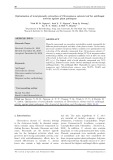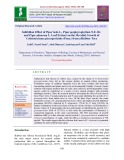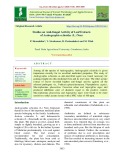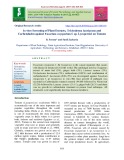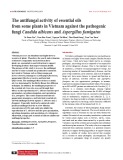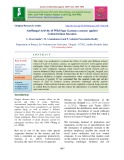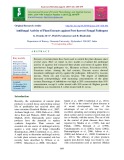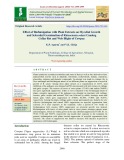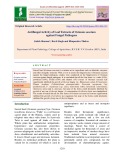
Anti-fungal activity of leaf extracts
-
In the study "Optimization of total phenolic extraction of Chromolaena odorata leaf for antifungal activity against plant pathogens", microwave-assisted extraction (MAE) variables were optimized for the extraction of the phenolic compounds from Chromolaena odorata (C. odorata) by using a central composite design (CCD) of response surface methodology (RSM).
 11p
11p  tieuvulinhhoa
tieuvulinhhoa
 22-09-2022
22-09-2022
 18
18
 2
2
 Download
Download
-
Anthracnose leaf disease in rubber trees, caused by the attack of Colletotrichum gloeosporioides, have led to the serious decline in natural rubber production. Continuous usage of synthetic fungicide leave the toxic residues that harm the surrounding animals and plants and are not environmentally friendly. It needs a better solution with organic products that are safer, more effective and biodegradable. Piper species could be considered as a source of new natural products with potential antifungal activities.
 9p
9p  trinhthamhodang11
trinhthamhodang11
 27-04-2021
27-04-2021
 15
15
 3
3
 Download
Download
-
Among all the species of Andrographis, Andrographis echioides is given importance recently for its excellent medicinal properties. The study of Andrographis echioides as anti-microbial agent was found necessary for gaining insight into this medicinal flora and its real value. The ethyl acetate extract of leaves recorded highest anti-fungal activity against all the selected pathogens viz., Pythium aphanidermatum, Phytophthora capsici, Macrophomina phaseolina...
 6p
6p  chauchaungayxua10
chauchaungayxua10
 19-03-2021
19-03-2021
 10
10
 2
2
 Download
Download
-
Fusarium oxysporum f. Sp lycopersici is the causal organism that causes wilt disease in tomato all over the world. The antifungal activity of aqueous extract of neem leaf (5%), ginger bulb (5%), Lantana camara (5%), Trichoderma harzianum (5%), carbendazim (0.01%) and combination of carbendazim+T. harzianum (0.01+5%) was investigated against Fusarium oxysporum f. sp lycopersici in vitro.The least growth of pathogen was recorded in Carbendazim (treated control) (94.00) followed by Neem leaf (35.20) followed by Lantana camara (31.11), ginger bulb (26.
 6p
6p  nguathienthan8
nguathienthan8
 20-10-2020
20-10-2020
 17
17
 1
1
 Download
Download
-
This study was conducted with the aim to assess the antifungal activity of four types of essential oils extracted from the King orange peel (Citrus sinensis), lemongrass (Cymbopogon flexuosus), peppermint (Mentha Arvensis), and betel leaf (Piper betle) on the two human pathogenic fungi C. albicans and A. fumigatus.
 6p
6p  chauchaungayxua8
chauchaungayxua8
 02-10-2020
02-10-2020
 7
7
 1
1
 Download
Download
-
Now these days, Plant extracts are used to control plant diseases because of their eco-friendly nature and cost effectiveness. The present investigation focuses on the antifungal activity of eight plant extracts determined through in vitro following poisoned food technique. Maximum inhibition of P. infestans was obtained by Salix sp. leaf extract (59.80% reduction) followed by Datura (48.47%). The other tested plant extracts exhibited moderate activity.
 6p
6p  trinhthamhodang1215
trinhthamhodang1215
 23-09-2020
23-09-2020
 8
8
 1
1
 Download
Download
-
In the present paper, we report the phytofabrication of MgO NPs using W. somnifera leaf extract for electrochemical sensing and their antifungal as well as cytotoxic activity. We have chosen the W. somnifera, known commonly as ashwagandha, which is a plant belonging to Solanaceae family as reducing agent (fuel) in the preparation of MgO NPs.
 9p
9p  tamynhan4
tamynhan4
 06-09-2020
06-09-2020
 10
10
 3
3
 Download
Download
-
This study was conducted to evaluate the effect of crude and different solvent extract of Leaf of Lantana camara, an aggressive invasive weed against plant pathogenic fungi Colletorichum falcatum causing Red rot of sugarcane disease under in vitro conditions. Aqueous crude extract and solvent extracts such as extracts Methanol, Ethyl acetate, Chloroform were tested at 2mg/mL, 4mg/mL and 8mg/mL concentrations. Results revealed that all the 3 solvent extracts showed significant inhibition at higher concentrations when compared to the Standard Fluconazole (15μg/ml).
 6p
6p  nguaconbaynhay6
nguaconbaynhay6
 24-06-2020
24-06-2020
 25
25
 1
1
 Download
Download
-
Extracts of certain plants have been used to control the plant diseases since several years. Here we report in-vitro studies to examine the antifungal activity of aqueous leaf extractsof three plants and neem oil against three post-harvest fungal pathogens viz., Rhizopus arrhizus, Sclerotium rolfsii, Fusarium solani. Among the leaf extracts, Duranta erecta showed maximum antifungal activity against the pathogens, followed by Lasonia inermis, Neem oil, and Cocculus hirsutus. The degree of inhibition increased correspondingly with increasing concentrations of the plant extracts.
 11p
11p  nguaconbaynhay6
nguaconbaynhay6
 23-06-2020
23-06-2020
 18
18
 1
1
 Download
Download
-
The aim of this study was to evaluate antifungal property of the Prosopis juliflora leaf extract as a potential natural source for synthesis of new drugs to avoid gaining of antifungal resistance. The Prosopis juliflora leaf extracts obtained by supercritical fluid extraction were assessed for their antifungal property against Rhizoctonia bataticola, Alternaria alternata and Colletotrichum gloeosporioides by food poisoned technique.
 9p
9p  cothumenhmong5
cothumenhmong5
 17-05-2020
17-05-2020
 15
15
 1
1
 Download
Download
-
Plants synthesize secondary metabolites and some of them as well as their derivatives have antimicrobial activity such as alkaloids, flavonoids, isoflavonoids, tannins, coumarins, glucosides, terpenes and phenolic compounds. An attempt was made to evaluate the in vitro antifungal and biofumigant nature of ten different plants on suppression of mycelial growth of R. solani. Among these plant extracts at a concentration of 12.5%, total inhibition of the pathogen was obtained on PDA incorporated with leaf extracts of cabbage and garlic creeper. The extracts of leaves of sweet potato (37.
 10p
10p  trinhthamhodang1212
trinhthamhodang1212
 06-04-2020
06-04-2020
 13
13
 1
1
 Download
Download
-
Sacred basil (Ocimum sanctum) is contains active ingredients such as alkaloids, enzymes and other inorganic elements. With a view to assess the fungitoxicity of Ocimum sanctum against the fungal pathogens, studies were conducted on the fungitoxicity of Ocimum sanctum against fungal pathogens. It is concluded that all the four forms i.e., crude (10%), powdered (10%), boiled (10%) and ethanol (1%) extract of Ocimum sanctum leaf significantly inhibited the growth of the test fungus viz., Rhizoctonia solani, R. bataticola, Phoma sorghina, Colletotrichum gloeosporioides, Fusarium oxysporum f.sp.
 5p
5p  kethamoi2
kethamoi2
 15-12-2019
15-12-2019
 16
16
 2
2
 Download
Download
-
The ethyl acetate and hexane extracts of leaves and stems of Clerodendrum inerme and Clerodendrum phlomidis (Verbenaceae) were screened for antifungal activity. Both ethyl acetate and hexane extracts of C. phlomidis stem and leaf exhibited appreciable inhibition on all the studied plant and human pathogenic fungi.
 4p
4p  vitamix
vitamix
 15-02-2019
15-02-2019
 17
17
 1
1
 Download
Download
CHỦ ĐỀ BẠN MUỐN TÌM









